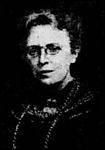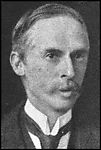 Clementina Black, champion of women's issues, spoke in favour of a minimum wage at the National Conference of Trade Unionists in 1906
Clementina Black, champion of women's issues, spoke in favour of a minimum wage at the National Conference of Trade Unionists in 1906 J. A. Hobson, economist and author, supporter of the minimum wage and speaker at the Conference.
J. A. Hobson, economist and author, supporter of the minimum wage and speaker at the Conference.

The awareness aroused by the Sweated Industries Exhibition held in London in 1906 led directly to the establishment of a powerful all-party pressure group, the National Anti – Sweating League (N.A.S.L.) J.J. Mallon was its secretary, with Sidney Webb and other leading Fabians and Mary Macarthur on its committee. The League carried on the work that the Daily News began with this first exhibition. It organised large scale exhibitions in many of the principal towns, including Liverpool, Leicester, Bristol, Ilford and Oxford. The Manchester exhibition ran for three weeks. In Birmingham it ran for ten. Following each exhibition, a branch of the National Anti-Sweating League was formed.
The League played an important role in converting the public to the idea of a minimum wage, and recognised the importance of gaining the support of the labour movement. To this end, the League decided to submit the principle to a national conference of trade unionists.
The conference took place in October 1906 at the Guildhall, London. Originally the conference was to last for two days, but such was the public interest that it was extended to a third day. Three hundred and forty-one delegates, representing two million organised workers, were in attendance. They listened to a series of lectures from experts in the subject. Among the many speakers were Clementina Black and J.A. Hobson. Clementina Black was a champion of women’s issues and had written several books on the problems of low pay. J. A. Hobson was an economist and author of a number of books and articles on the subject. Many of the speakers agreed that voluntary action was ineffective. Consumers’ leagues in Britain and America, designed to dissuade people from buying the products of sweated labour, had achieved little. Legislative action was the only answer.
In his address, J.A.Hobson, argued that cheap labour did not lead to cheap production, and that higher wages and shorter hours improved the quality of the goods produced. He predicted that an enforced rise in wages would lead to progress, for a trade dependent on cheap and sweated labour was an unprogressive trade. He believed that if sweated workers received higher wages, they would use their increased purchasing power to buy more and better goods, which in turn would stimulate more industry and more demand for labour. An economy based on the luxurious expenditure of the wealthy would be replaced by the workers’ demand for necessities or conveniences.
Sidney Webb also spoke at the conference and reinforced the case that many of the arguments against a minimum wage were based on economic misconceptions. The effect of the conference was to give the minimum wage the widespread support it needed to turn the principle into practical politics. As J.J.Mallon said in his address at the Ilford exhibition, referring to the branches of the League, “Their work and the work directed from the Central Office has been fruitful beyond expectation, and after two years of strenuous agitation a demand for legislation exists too widespread to be ignored.”
As the pressure grew, a commissioner, Ernest Aves, was sent to Victoria, Australia in January 1907, to investigate the operation of wage boards, introduced there in 1896. Also in 1907 a Select Committee of the House of Commons on Homework was appointed. Mary Macarthur, an executive member of the National Anti- Sweating League was one of the people called to give evidence. Mary’s biographer, Mary Agnes Hamilton, writes that so impressed was the Committee, that the Members of Parliament were anxious to see some of the sweated workers on whose behalf she had been speaking. The session was held in private, and Mary reinforced what the women had to say with an experience of her own. Among the trades from which the Select Committee had asked for evidence was the baby linen trade. Mary had often been puzzled about why there were numbers of newspaper advertisements from families offering baby outfits for sale. She sent for one and traced where it had been made. This took her to one of the worst slums in London, where she found a girl making little lace trimmed garments by the dozen, at a rate of one penny each. The girl had incipient diphtheria. She was poor and possessed no bedclothes, and so covered herself at night with the baby linen she was working on. As a result of handling the cloth Mary herself contracted diphtheria and spent six weeks in hospital. This story demonstrated to the Committee in the most vivid way, the consequences of sweated labour. “When they saw it as setting death in the folds of a baby’s robe, they shuddered.” (Hamilton, 1925, p.80)
Reporting in 1908, the Committee concluded that only legislation could curb the problem of low pay. It did not recommend a national statutory minimum wage, but the establishment of wage boards, on the grounds that the boards, made up equally of employers and employees, would make sure decisions would not damage the trade, but would be based on what their particular trade could stand. Thus Australia’s wage boards, with their selective minima, became the model for Britain’s trade boards established in 1909.
Rollover the captions in the box to see the available images in thumbnail format, click the caption to see the full-size image
| Reference: | 720 |
| Keywords: | |
| Archive Ref: | |
| Updated: | Thu 12 Jul 2007 - 1 |
| Interpretation written by | Barbara Harris |
| Author's organisation | |
| Organisation's website |